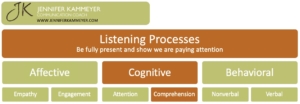Through the Listening Lens: Same Words, Different Meaning
Just like wearing colored glasses changes how we see things, our listening lens changes how we hear things. We all hear something different through our own particular listening lens. Our listening lens is created by the sum total of all we have learned and experienced in our lives. This lens shapes how we take in the world.
Knowledge of the listening lens, and the discovery of both our own and others’ lens in interactions, gives us vital information to become better communicators. This knowledge can unveil the difference between what we think we are saying and what others are hearing and vice versa. It can help us clear up misunderstandings.
Recalling the listening processes framework from The Year of Better Listening blog, this skill falls in the Cognitive category of Comprehension. It is the skill of becoming a better listener through comprehending the lens that is influencing interpretations.
Through the Listening Lens
Through what lens am I listening?
We can take a minute before interacting with someone – or even a few seconds during an interaction – to see what is going on inside our own heads about the person or the situation. There may be some expectation about how this interaction will go based on how other interactions like this went in our previous experience. There might be some hidden bias present based on what we have learned. We can notice our listening lens in an interaction and acknowledge that it is not neutral. It is important to acknowledge that our lens is influencing how we perceive and interact with others. With this insight we can adjust our communication. For example, we can adjust our expectation and approach the situation with curiosity about how it will play out this time.
Through what lens are others listening?
We can pick up clues about others’ listening lens based on what they say, their body language, and how they react to us. If we are saying something we intend to be positive, we can notice if the reaction is positive. In particular, when we get a reaction that we do not expect, instead of immediately getting defensive we can pause and think what possible listening lens could have generated such a reaction. For example, if we say ‘that was fast’ with the intention of praise and we get a frown, perhaps the listening lens of the other person is that fast means poor attention to detail.
We can also use the technique of asking open-ended questions such as ‘what does that bring up for you?’ to better understand others’ interpretation of what was said. By actively listening without judgment, we may be able to better understand how to bridge the gap between our intention and their interpretation of what we said.
Practice: Listening Lens Awareness
Last month, we practiced with paying attention and keeping our focus on the person(s) with whom we are interacting. This month, we build on that skill by focusing on the listening lens at play in an interaction. We cognitively acknowledge our own lens and how it is influencing the interaction, and we seek clues about the listening lens of others. Let’s practice this during times of misunderstandings this month.
- Notice that there has been a difference in interpretation of meaning
- Acknowledge our own listening lens at play in the moment
- Gather clues about others’ listening lens at play
- Ask open-ended questions to clarify meaning
Our lives today include interactions with people from many different cultures with vastly different life experiences. While we may have a more similar listening lens to those with shared backgrounds, we severely limit ourselves if we can only listen to people with a similar lens. Seeking to see things from others’ perspective and really thinking through the lens of the listener helps us comprehend possible interpretations, making us better communicators.

